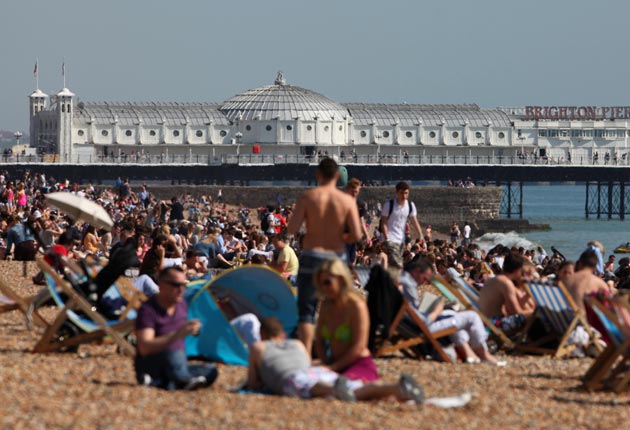Summer comes early, but heat brings threat of drought for millions
The South is basking but after driest March in 50 years experts warn that water could soon be rationed

The weekend sunshine might be more than welcome, but water companies are beginning to cast a wary eye over reservoir levels after the driest March in southern England for half a century.
Although no companies are yet signalling formal drought alerts, some reservoir stocks are lower than they should be. In the south-west, Bristol Water has been forced to pump supplies from the Severn to maintain its levels. The company's main source, Chew Valley Lake in Somerset, is 20 per cent below normal levels for this time of year.
The dry March was caused by a "north-west/south-east split" in Britain's weather, which is continuing and is responsible for the recent sunny weather in the south, which is promising such a bright weekend. The "Azores high", the high-pressure system to the west of Spain, has been extending its influence north and east towards the British Isles, meaning that the westerly Atlantic lows which bring spring rains to the UK have been forced further north.
So while the UK as a whole had nearly 80 per cent of its normal March rainfall, and northern England, Scotland and Northern Ireland have had a wet start to the spring – there was a flood warning in Scotland yesterday – the south has been astonishingly dry.
Southern England and Wales have had their driest March since 1961, with each area having only a quarter of the expected rainfall. The driest region, East Anglia, had only 15 per cent of its normal precipitation in its driest March since 1929, and the second-driest since records began in 1910. Water UK, the umbrella body for the water companies in England and Wales, says there is "currently no concern about water supplies, but we are keeping an eye on things after what was a very dry March".
But the situation could change relatively quickly, if the dry weather runs on through April. A water company nightmare would be a repeat of the drought of 1995, or even worse, 1976, when water supplies were rationed.
The Met Office is suggesting that the pattern of a dry south and wet north is likely to continue over the next month. "England and Wales should still have a lot of fine and dry weather with some long spells of sunshine during the day," says its forecast for up to the end of the first week in May. "There will also be some showers or rain at times but rainfall should be below normal. Temperatures will be generally near normal or above normal everywhere."
As for this weekend, much of the country will be sunny and warm on both days, with some places very warm, even – dare we use the word? – hot. The forecast for the weekend is so good that the RSPCA has issued a warning to pet-owners reminding them of the dangers of leaving animals in hot cars, conservatories or caravans. "Often, owners make the mistake of thinking that it is sufficient to leave a bowl of water or a window open for their pet, but this is not enough to protect your pet from heatstroke, which can have fatal consequences," the charity said. Outside temperatures of 22C, recorded in southern England this week, could lead to the temperature in a car soaring to 47C in an hour. And Britain's bookmakers are braced for the busiest day of the year today with the Grand National at Aintree. The bookies believe the fine weather will encourage people to go out into the high street and place a bet.
"We expect more than half the adult population to place a Grand National flutter, betting £150m on the big race alone, on a day when industry-wide turnover could top £300m," said a spokesman for bookmaker Coral.
A dry look at history
*1854
A crippling drought affected much of the country, contributing to a massive cholera epidemic as people were forced to drink contaminated water. These conditions persisted for four years, inspiring meteorologist George Symons to found the British Rainfall Organisation, the world's first rain monitoring network. Partly as a result, Britain's climate is still among the most measured and studied in the world.
*1931
While the dustbowl turned America's farm-land to stubble, and severe famine struck Russia, western Europe also felt the effects of the 20th century's most far-reaching drought. In Britain, the period from April to October was the driest since records began in 1727, and weather stations in Kent recorded the lowest rainfall ever reliably recorded in Britain – less than 10 inches for the whole year.
*1976
The baking summer of 1975 was followed by a dry winter and spring, culminating in the famous drought of 1976. Rivers dried, emergency standpipes were set up, and, in desperation, the government appointed Denis Howell Minister for Drought as it battled the driest summer in 300 years.
*1995
There were short but extreme drought conditions from April to August. Unusually, northern areas of the country were worse affected than the south, and conditions were exacerbated in Yorkshire by mismanagement and leaks which led to the near-exhaustion of reservoirs. Feeling was so strong water company employees were advised not to wear uniforms in public.
Josephine Forster
Subscribe to Independent Premium to bookmark this article
Want to bookmark your favourite articles and stories to read or reference later? Start your Independent Premium subscription today.

Join our commenting forum
Join thought-provoking conversations, follow other Independent readers and see their replies